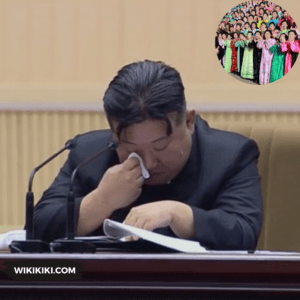North Korea’s leader, Kim Jong un, was captured on camera crying during a National Mother’s Meeting in Pyongyang on December 3. The display was part of an orchestrated plea to address the decline in the country’s birth rate.

Also Read: GTA 6 Trailer Released, Will be Available in 2025
Kim Jong un appealed directly to the women of North Korea, urging them to contribute to reversing this trend and addressing the role mothers play in the nation’s future.
Kim Jong un addressing the gathered women as Dear Mothers, conveyed the situation, stating, “Preventing a decline in birth rates and good childcare are all of our housekeeping duties we need to handle while working with mothers.” The emotional outburst was a rare moment from the leader.
The incident has spread discussion about the causes of North Korea’s declining birth rate and the consequences for the nation’s future.
According to estimates from the United Nations Population Fund, North Korea’s average fertility rate stood at 1.8 in 2023.
This figure indicates a decline in birth rates over recent decades, posing challenges for a country that relies on a mobilized labor force to sustain its economy, especially considering the sanctions it faces.
Some neighborhoods in North Korea still exhibit higher fertility rates than others, showcasing regional variations in this downward trend.
The situation is similar demographic challenge faced by neighboring countries like South Korea and Japan.
South Korea struggling with its own record-low fertility rate of 0.78 last year, has witnessed a shortage of pediatricians and has resorted to organizing matchmaking events to boost birth rates.
Also Read: Nigerian Army Drone Strike Accidentally Kills 85 Civilians
The decline in birth rates is not only a concern for the well-being of the population but also has impact for the economic and social fabric of these nations.
A report by the Seoul-based Hyundai Research Institute suggests that North Korea, lacking sufficient resources and technological advancements, could face challenges in reviving and developing its manufacturing industry if an adequate labor force is not provided.
This underlines the economic consequences of a declining birth rate for a nation already struggling with limited resources. North Korea has taken steps to encourage families to have more children.
The Kim Jong Un government has introduced a set of benefits for families with three or more children, including free housing arrangements, state subsidies, free essential goods, and educational perks for children.
These measures are aimed at alleviating the financial burden on families and incentivizing an increase in childbirth.
Reports suggest that the leader acknowledged the hardships he faces in dealing with the party and state’s work, expressing gratitude to mothers for their role in strengthening national power.
Also Read: Pakistan: At Least 4 Injured in Peshawar Public School Blast
This emotional plea may resonate with the population, influencing attitudes towards family planning. Historical factors, including birth control programs implemented in the 1970s and 1980s to slow postwar population growth, have contributed to the current demographic challenges.
Additionally, a famine in the mid-1990s, estimated to have claimed hundreds of thousands of lives, led to a decline in the fertility rate.
North Korea, considering the implications for regional stability. While sanctions and geopolitical tensions continue to shape the nation’s trajectory.
Projections by the Hyundai Research Institute indicate that North Korea’s population is expected to shrink from 2034, dropping to 23.7 million by 2070.
These projections underline the urgency of addressing the declining birth rate to ensure the country’s sustainable development.
Kim Jong un’s emphasis on instilling communist values in children and promoting family harmony reflects the ideological underpinnings of the regime.
The role of mothers in shaping the younger generation to be committed to the revolution is presented as a primary revolutionary task.
Also Read: Thailand Bus Crash: 14 killed and More than 20 Injured























